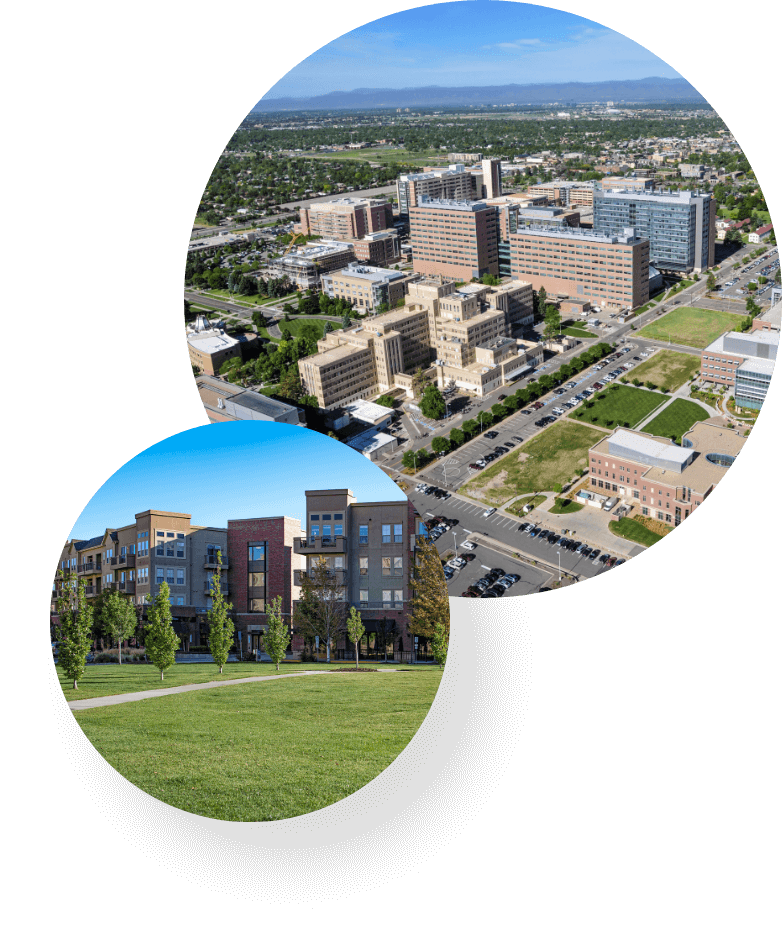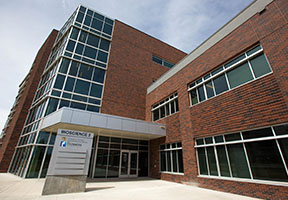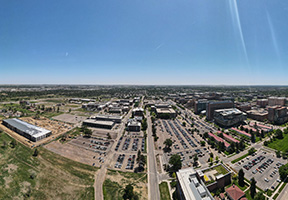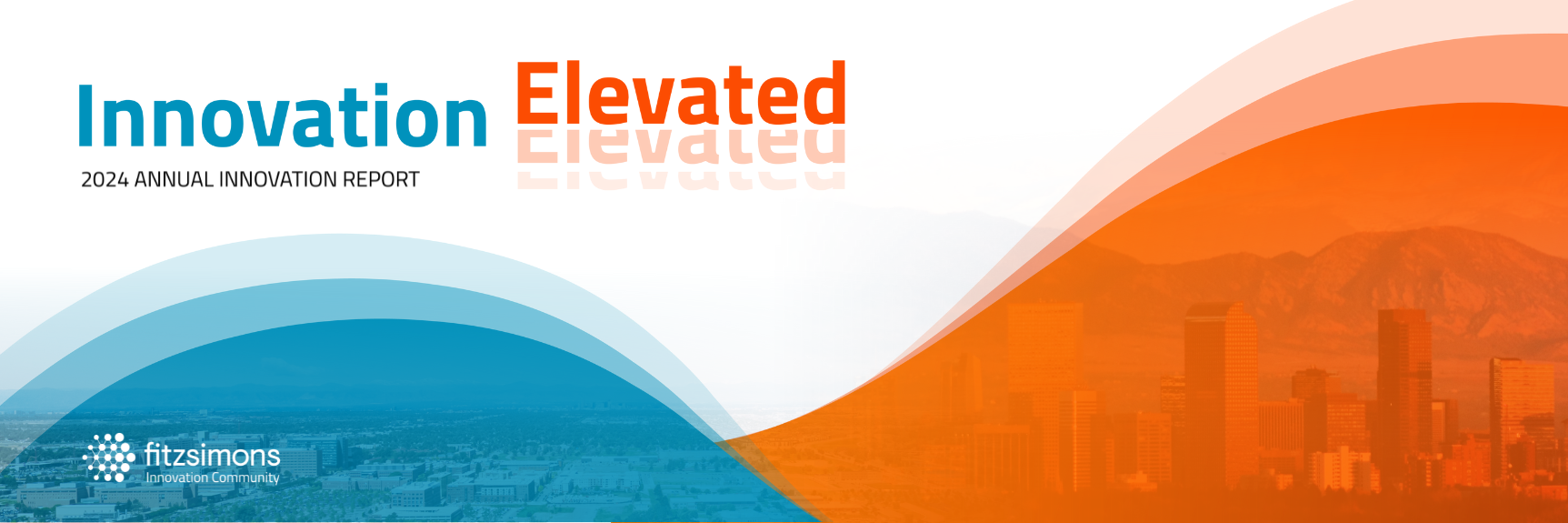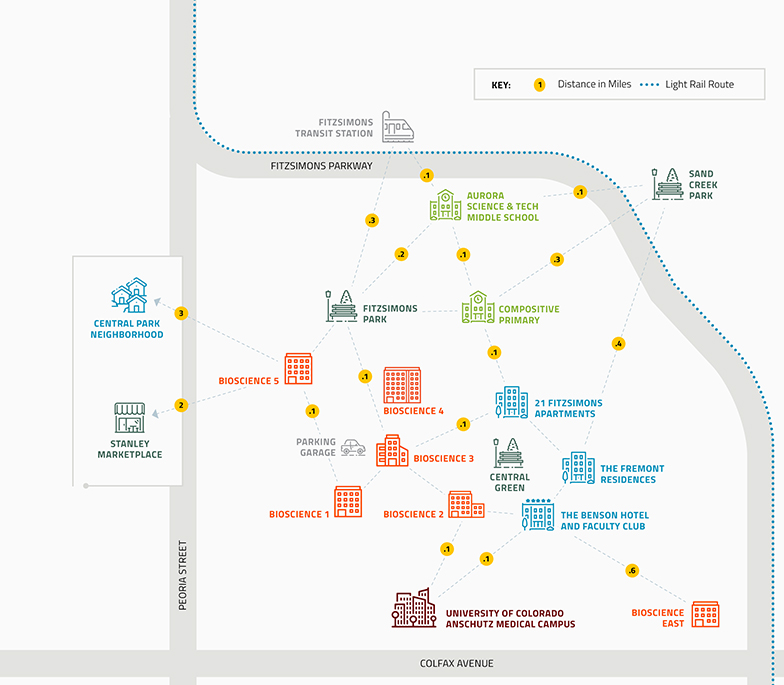A partnership building bright futures.
By: Fitzsimons Innovation Community
In almost every sentence where Fitzsimons Innovation Community is mentioned, so too is our proximity to and partnership with the University of Colorado Anschutz Medical Campus. Breakthrough work requires strong partnerships, and the relationships we facilitate with the clinicians, researchers, business leaders, and policymakers in our area create the connections our health innovators need for success. At the heart of so many of these relationships are the University of Colorado Anschutz Medical Campus and CU Innovations. This month, we were honored to talk with Gali Baler, Ph.D., Managing Director of Strategy and Operations for CU Innovations at the University of Colorado Anschutz Medical Campus, and Director of Investments at the CU Healthcare Innovation Fund.
The CU Innovations vision is to advance, not just internal technology, but the broader assets that are available on the campus, such as the subject matter expertise of clinicians, the abilities of laboratories to test and validate, the infrastructure of the hospital system to engage with outside groups in delivering better experiences for patients and providers, and most importantly, to make bigger impacts in patients’ lives through novel technologies.
It only makes sense that so much of that vision overlaps with the things we’re doing here at Fitzsimons Innovation Community, and Baler told us that’s why it’s such an important partnership to CU Innovations. “Fitzsimons Innovation Community is a very dynamic place to engage the healthcare environment. There is an infrastructure in place that allows us to easily evaluate opportunities. Though not all of them make sense for us to pursue, we are able to quickly begin full support of the opportunities that move the needle and help us deliver better care for patients.”
Baler explains, “CU Innovations is a modern tech transfer office, but it’s much more than intellectual property (IP) management. Most tech transfer offices handle the IP that gets submitted from faculty, but here we also engage the campus and find ways to unlock opportunities downstream, particularly in partnership with outside companies.”
When it comes to those outside companies, Fitzsimons Innovation Community seems to have just what CU Innovations needs. Many of the companies in our Community have worked with CU Innovations to further their research and make use of important investment dollars that help advance developments in patient products and care. It doesn’t hurt that these “outside companies” happen to be right across the street. For example:
Summit BioLabs: Summit BioLabs was initially focused on developing diagnostic testing for head and neck cancers, however the pandemic changed their trajectory quickly. With help from the CU Innovations SPARK program—a grant program built to fund new technologies on campus—Summit BioLabs was able to pivot to development of diagnostic testing for COVID in 2020 and ended up providing almost a third of all COVID testing for the state of Colorado. When this increased demand led to a need for laboratory space, they were able to set up in Bioscience 3 on the Fitzsimons campus and expand and build out their labs there. This is a great example of how a technology developed on the CU Anschutz Medical Campus was able to take advantage of the Fitzsimons Innovation Community space for adaptation, incubation, and expansion, and then make a huge impact for our state at the height of the pandemic.
HepQuant: HepQuant is a company that developed a shunt test that checks liver function. This organization is special because they are currently incubating in Bioscience 1 in a space leased by CU Innovations as the “Startup Foundry.” The Startup Foundry is different in that it creates a space for startups to move out of the university and lease a single bench for their research. So many other incubation communities require organizations to lease much larger spaces that they often can’t afford during this critical growth period. The CU Innovations Startup Foundry in Bioscience 1 allows smaller companies to get their footing in an affordable way while in the development phase. HepQuant is currently doing clinical testing in this space in Bioscience 1, and Baler gave a proud smile when he told us that they are likely soon to move out of the Startup Foundry space because they’ve grown so much.
So, besides investment capital, how does CU Innovations help get these startups and new technologies off the ground? Baler was happy to explain it to us. “There are several resources that CU Innovations provides to health innovators on the Fitzsimons campus—to start: collaboration opportunities and grant funding. We have mechanisms that are specifically intended to fund CU Anschutz Medical Campus faculty innovators, and some of those require some kind of outside participation. This means we can co-fund a project where we fund our researcher and their partner company on the outside so that we soon have an ongoing collaboration or pilot project. CU Innovations also provides mentors and advisors for our SPARK program that can be leveraged for companies over at Fitzsimons.” These elements, plus the guidance and support CU Innovations offers down the road, continue to be important success factors for several of the Fitzsimons Innovation Community organizations.
With several companies at Fitzsimons Innovation Community working with CU Innovations and other partners on the University of Colorado Anschutz Medical Campus, we wanted to know what advice Dr. Baler has for organizations who want to forge these types of relationships and investments. His biggest piece of advice was: ENGAGE. “There are so many companies on the Fitzsimons campus doing amazing things, but I don’t get the chance to know about them because they don’t engage with the medical school campus. The easiest thing they could do is to reach out. There’s a litany of resources on the campus—including people working across the spectrum from pediatrics to geriatrics—so you could probably find a clinician working on the same type of problem that may have important insight.”
Baler highly suggests reaching out, especially given the proximity, and looking at the accelerator programs offered by CU Innovations. This connection between Fitzsimons Innovation Community organizations and the mentors and advisors in the programs on the CU Anschutz Medical Campus has proven results in helping startups progress.
For the past eight years, Dr. Baler has been working for CU Innovations, and in that time, he has learned that there are many innovation-minded clinicians and researchers on the CU Anschutz Medical Campus who are excited to lean into new technologies and ideas. In addition, almost every new idea being researched comes through the CU Innovations clearinghouse, so they have their finger on the pulse of what is in development and how those developments might pair well with work being done by startups at Fitzsimons Innovation Community. We know around here that innovation is a team sport, and with help from CU Innovations in finding the right collaborations, investments, or partnerships for your organization, the next big advancements in patient care—from data-driven drug discovery to the newest in diagnostics—are right around the corner. To us, that sounds like a perfect match.
